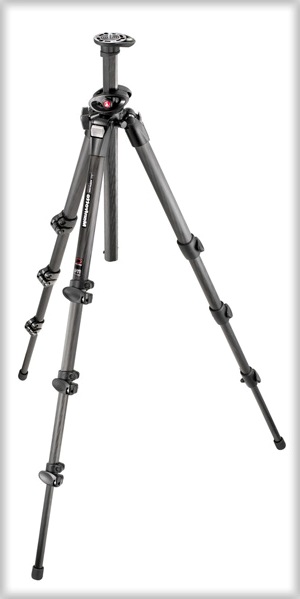
A camera tripod and ball head are must have items for every photographer’s toolkit if you want to avoid camera shake and create really sharp images. They are used for macro, landscape, low-light or night, and portrait photography, just to name a few, and are the only way to go to create images using slow shutter speeds.
When choosing these pieces of camera equipment, you’ll want to consider not only your existing equipment, but possible future equipment, so it will meet today and tomorrow’s needs. You’ll also want to consider the long-standing reputation of the manufacture, which represents years of experience and product quality. You’ll know your equipment will hold up time and time again for many years to come.
Manfrotto is one such company. They have been in existence since the 1960’s and have dedicated themselves to producing high quality, professional tripods and ball heads.
TRIPODS
You’ll want to consider these features when choosing a tripod:
1. Is it made of aluminum, carbon fiber, carbon fiber/magnesium or basalt?
2. What does the tripod weigh and is it easy to carry in the field?
3. Can it support the weight of your ball head, camera and lens as well as future heavier lens?
4. When the legs are fully extended, is your camera at eye level without extending the
center column (include tripod, tripod head and camera)?
5. How many legs sections are there and how do they lock (quick lock, twist lock, self-
locking)? Can they collapse to a length that provides convenient portability?
6. Is the tripod sturdy and rigid when legs are extended to their maximum height?
7. Does it have a center column and can it be adjusted both vertically and horizontally?
8. Is it versatile, quick and easy to use while photographing?
A Look at the Manfrotto 4 Section, 055 Carbon Fiber Tripod-Q90
Manfrotto has gone out of its way to create a tripod that is made with the professional photographer in mind, but you certainly don’t have to be a professional to enjoy all of its attributes. It’s lightweight, sturdy, rigid and extremely versatile and has all the features you’ll need now and in the future.
FEATURES
Product Materials:
The Q90 Carbon Fiber Tripod has 100% carbon fiber tubes with magnesium castings. As Manfrotto states, “We chose to reach the maximum quality using 100% carbon fiber and the pull winding technology (a special production process able to maximize performance, resistance and reliability).”
Carbon fiber materials mean lightness. It weighs in at 3.75 pounds. And carbon fiber means strength and toughness. This is one sturdy and stable tripod.
Note: I would still purchase or create a tripod strap for ease of portability during long treks to your chosen location.
Load Capacity:
Unless you are a professional photographer who is placing a huge amount of camera and lens equipment on your tripod, you’re not likely to have any issues with the amount of weight you can place on this tripod, as its load capacity is 17.64 pounds. Even with your ball head, camera and larger, heavier lenses, you should have some weight to spare. And if you’re photographing during a windy day and want more weight/counterweight stability, you’ll be able to hang a 3-4 pound bag from its strap over the convenient hook at the top of the tripod without worrying about overloading the tripod.
Note: I would add the total weight of you ball head, camera and heaviest lens to see how much more weight you can hang from the hook. It’s always better to be safe than sorry!
4 Section Legs and Height:
This tripod has 4 sections to each leg, which means it will give you better height adjustment capabilities, and when collapsed, you’ll get the advantage of a more compact tripod that measures 21.46 inches, which in turn means easier portability.
With the quick release leg locking levers, it’s quick and easy to adjust the height of the legs. Just flip open the lever, slide the telescoping legs to the required length and snap/lock them shut. And if you need to have the legs set a various heights, you can still level the tripod by checking the built in spirit level on the ball head mount plate.
The maximum tripod height is 66.93 inches (with center column down – 53.35 inches). Once you attach the ball head and camera you’ll be at approximately 62 inches, which is perfect if your height is around 5 foot 8 inches. You can easily adjust the height of the center column if you are taller. There was some concern with loss of camera stability when the center column was extended to its maximum length, however I found the tripod with my camera was still quite stable.
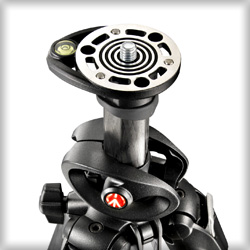
Mounting plate with spirit level.
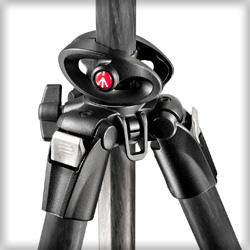
Leg angle locking buttons.
You can also adjust the angle of each leg at the same angle or independently with a locking button at the top of each leg. You can achieve 4 angles; 23°, 47°, 66° and 89°. By merely swinging out a leg or two allows for quick adjustments on uneven terrain.
Center Column:
The Q90° column not only adjusts the vertical height of the center column by merely unlocking and relocking a knob, but you can just as easily adjust it to horizontal position, getting your camera better positioned for overhead images or just inches off the ground for those close-up photos. This is just one feature that makes it a very versatile tripod.
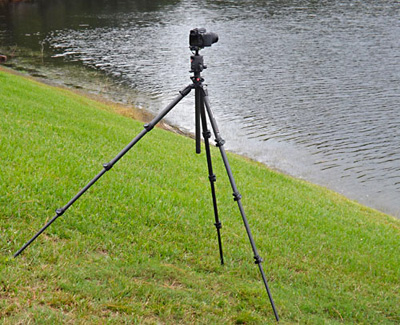
It’s easy and quick to
swing out a leg when on a hill.
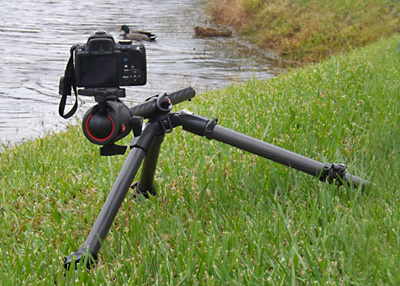
Adjusting the center column from vertical to horizontal and pulling up the legs takes no time at all when you want to get down close to the action.
I would highly recommend the 055 Carbon Fiber – Q90 – 4 Section Tripod for both professional and non-professional photographers. It will meet all of your tripod needs for small to medium format cameras, whether digital or conventional. Be sure to add a Manfrotto tripod to your photography toolkit.
Note: I do miss the rubberized grips on the upper legs. Manfrotto may have removed then to reduce the weight, but it makes for easy non-slip gripping of the legs.
Take another look at this carbon fiber tripod and pick yours up today.
A 3 section, aluminum tripod of the same likeness will weigh in at 5.29 pounds, be slightly longer, and have a lower price point. Your pocket book may play a role in your decision, but whichever you choose, you’ll be getting a great tripod.
BALL HEADS
The head that holds your camera and mounts on the plate of your tripod is probably more important than your tripod, because it gives you the precise control over your camera’s position. There is a variety from which to choose, like the three-way, geared, ball or pano head used for photography, and the pan and tilt and fluid heads for video or wildlife photography, but you’ll find that the vast majority of professional photographers will choose the ball head. Once again, you’ll want to go with a company such as Manfrotto – one that has a great reputation for manufacturing quality, professional ball heads.
You’ll want to consider these features when choosing a ball head:
1. Does it have the strength to hold the weight of your camera and lenses and any future equipment of
heavier weight?
2. Do you need to screw the camera on the head or does it have a quick release?
3. How smoothly do the components move?
4. Does it have precision, multi-angle versatility?
5. Once a camera angle and position is chosen, how quickly, easily and securely can you lock down that position?
6. Are spirit levels included?
7. Can you adjust both for panning and ball position independently?
8. Can you adjust the friction (ease of movement) on the ball?
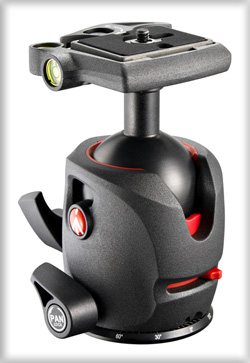
A Look at the Manfrotto 055 MAG Ball Head-Q2
This lightweight (2.03 pounds), compact and durable magnesium ball head is one of Manfrotto’s best pro heads and has been dedicated to the carbon fiber 055 series tripods. It will surely meet all of your required features, along with any future requirements.
It is 5.16 inches high and has a load capacity of 26.46 pounds, so you should have no issues with it supporting the equipment you own today or your future camera and lens choices.
Once the head is screwed on to the tripod plate, you can tighten the 3 set screws under the tripod mounting plate, so you don’t have to worry about the head loosening accidentally. And, you can mount any camera to the head via its quick release plate. It comes with a ring attached to the “home camera screw”, which is very convenient (no nickel or screwdriver needed) and is also great for attaching a tripod socket mounted camera strap.
It has 3 independent rotating levers. One that locks and unlocks its 360° panning feature, one that locks and unlocks the angle of the ball, which provides for a lateral tilt of -100° / +40° head tilt, and one that tightens or reduces the ball friction. It does take a bit of finger strength to unlock and lock the levers, but once they are locked, there is no creeping or movement caused by the weight of the camera and lens. The functions of panning and tilting of the ball move very smoothly.
It comes with two spirit levels that are incorporated within the camera mounting plate: both vertical and horizontal.
It functions well in the field is sturdy and stable, and above all, extremely versatile.
You can’t go wrong with this Manfrotto ball head, so add this one to your camera equipment wish list.
Note: Although these items are more expensive than many of lesser quality,
they are purchases that will last you for many, many years.
Visit Manfrotto.us to view all of their photography products.
by Marla Meier, APM Editor
Review: © 2012 Marla Meier. All rights reserved.

Leave a Reply